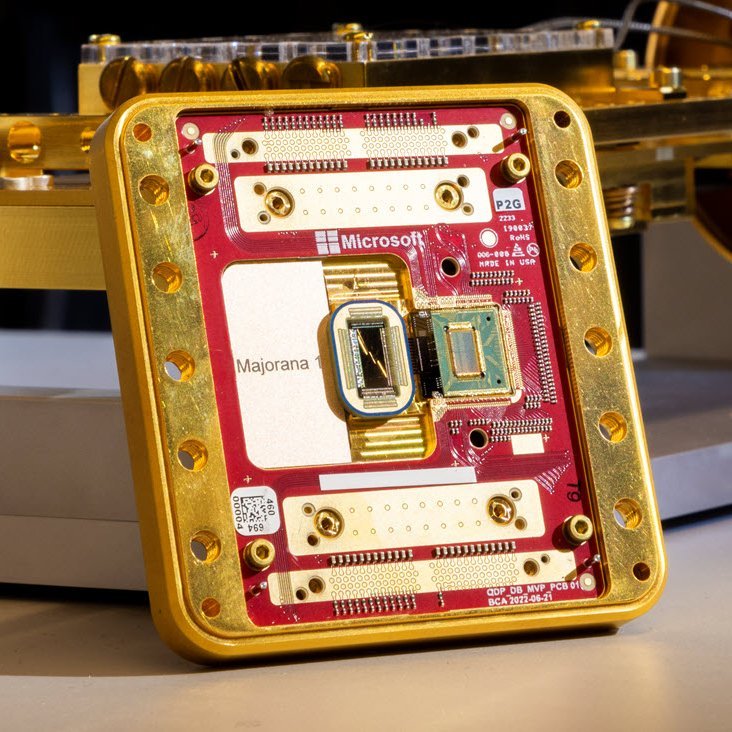Microsoft has unveiled its latest innovation: the Majorana 1, a quantum chip powered by something called a Topological Core. Unlike traditional quantum chips, this one uses an entirely new class of materials known as topoconductors. Think of topoconductors as Superconductors 2.0—they behave like superconductors but come with built-in quantum stability. But what makes them truly revolutionary? They enable the creation of Majorana particles, which are essential for building topological qubits. These qubits aren’t just faster or stronger—they’re fundamentally more stable than anything else out there.
Wait, What’s the Difference Between Silicon Chips and Quantum Chips?
Traditional silicon chips work using bits , which are either a 0 or a 1. That’s the foundation of all modern computing. But quantum chips use qubits , which can be 0, 1, or both at the same time thanks to a phenomenon called superposition . This allows quantum computers to process massive amounts of data simultaneously, solving problems that would take classical computers thousands of years in just seconds.
“But here’s the catch: current quantum chips, like the ones from Google and IBM, use superconducting qubits . These are incredibly powerful but also super fragile . Even the tiniest disturbance—like heat, radiation, or noise—can cause them to lose their quantum state, a problem called decoherence . That’s why today’s quantum computers are huge, expensive, and need to be kept at near absolute zero temperatures.”
Instead of relying on single-point storage like traditional qubits, topological qubits spread information across a quantum system. Imagine a braided rope—if one thread breaks, the whole structure stays intact. Similarly, topological qubits are far less prone to errors because they’re protected by the unique properties of Majorana particles. This makes them more stable, reliable, and potentially scalable.
The Science Behind It: What Are Majorana Particles? “Matter Meets Antimatter”
Let’s rewind to 1937 when Italian physicist Ettore Majorana first theorized these elusive particles. A Majorana particle is unique because it’s its own antiparticle—a rare phenomenon that combines matter and antimatter into one entity. But here’s the kicker: they only exist in very specific quantum states and exhibit something called non-abelian properties. In plain English? If you swap two Majorana particles around each other, the system “remembers” the swap. This memory effect is key to creating fault-tolerant quantum computing, where errors don’t derail calculations.
A New State of Matter? “Beyond Solid, Liquid, and Gas
Here’s where things get mind-blowing. Traditional states of matter include solids, liquids, gases, plasma, and even Bose-Einstein condensates. But Microsoft’s work introduces a whole new state of matter tailored specifically for quantum computing. This new state allows scientists to create and control Majorana particles reliably. And why does that matter? Because these particles form the backbone of topological qubits, which could revolutionize everything from drug discovery to cryptography.
How Does Majorana 1 Differ From Other Quantum Chips?
Most quantum computers today use superconducting qubits, like those developed by Google and IBM. While impressive, these qubits are notoriously fragile. They need to maintain a delicate balance called superposition, but even the slightest disturbance—heat, radiation, or noise—can cause quantum decoherence, losing valuable data mid-calculation. Enter Microsoft’s Majorana 1. Instead of relying on single-point storage, topological qubits spread information across a quantum system. Imagine a braided rope: if one thread breaks, the whole structure stays intact. Similarly, topological qubits remain resilient against disturbances, making them far less prone to errors. Why Topological Qubits Are a Big Deal “Braiding the Future of Quantum Computing” The secret sauce behind topological qubits lies in their ability to leverage Majorana particles. Their exotic quantum states act as natural shields, protecting qubits from interference. This means fewer errors, longer coherence times, and ultimately, more reliable computations. And the best part? Microsoft claims that a single Majorana 1 chip could potentially house up to a million qubits. That’s not just scaling—it’s a quantum explosion of possibilities.
Real-World Applications: What Can We Expect?
From Medicine to Materials Science” With this level of power, the potential applications are staggering: Drug Discovery & Personalized Treatments: Simulating molecular interactions at unprecedented speeds. Cryptography & Security Protocols: Developing unhackable encryption methods. Super Materials: Designing materials with extraordinary properties, like ultra-lightweight yet incredibly strong alloys. Imagine curing diseases faster, securing global communications, and inventing materials straight out of science fiction—all thanks to quantum computing.
Can We Make Laptops or Phones with Quantum Chips?
So, here’s the million-dollar question: can we slap one of these quantum chips into a laptop or phone? Well, not yet—but let’s break it down.
Right now, quantum computers are massive machines that require insane cooling systems to function. They’re not exactly something you can carry around in your pocket. However, Microsoft’s breakthrough with the Majorana 1 chip could change that in the future. Because topological qubits are more stable, they might not need the same extreme conditions as current quantum chips. If researchers can figure out how to miniaturize these systems—and keep them stable at higher temperatures—we could eventually see quantum chips integrated into everyday devices.
“magine a smartphone that can simulate molecular interactions in real-time, helping you design custom medicines tailored to your DNA. Or a laptop that can crack encryption codes in seconds (though, uh, let’s hope that doesn’t fall into the wrong hands).
But don’t hold your breath just yet. We’re still years away from seeing quantum chips in consumer electronics. For now, they’ll likely remain in specialized labs and data centers, tackling problems like drug discovery, climate modeling, and advanced AI training.
Can Quantum Computers Solve Everything Faster?
Not exactly. Quantum computers aren’t universally faster than classical computers. They’re only better at certain types of problems, particularly those involving massive parallelism or complex optimization.
For example, quantum computers could revolutionize fields like cryptography by quickly factoring large numbers—a task that would take classical computers millennia. But for simpler tasks, like sending an email or running a spreadsheet, a quantum computer wouldn’t offer much of an advantage.
In fact, there are plenty of algorithms that classical computers will always handle better. So, don’t expect your gaming rig to be replaced by a quantum machine anytime soon.
When Will We See Real-World Impact?
Years, Not Decades” While challenges remain—like testing, scaling production, and reducing costs—Microsoft believes practical quantum computing applications are closer than ever. According to their team, we’re looking at a timeline of years, not decades, before quantum tech starts impacting everyday life. Conclusion: Why Majorana 1 Matters “The Quantum Revolution Starts Now” Microsoft’s Majorana 1 chip isn’t just a milestone—it’s a paradigm shift. By harnessing the power of topological qubits and Majorana particles, we’re stepping into a world where quantum computing becomes robust, scalable, and accessible. So whether you’re a scientist, entrepreneur, or simply someone curious about the future, keep your eyes peeled. The quantum revolution is no longer a distant dream—it’s happening right now.
What Are the Risks of Quantum Computing?
With great power comes great responsibility, and quantum computing is no exception.
One of the biggest concerns is encryption . Many of the encryption methods we rely on today—like RSA and ECC—are based on the difficulty of factoring large numbers. A sufficiently powerful quantum computer could crack these codes in seconds, potentially exposing sensitive data like bank accounts, medical records, and government secrets.
But don’t panic just yet! Researchers are already working on quantum-resistant encryption —new algorithms that even quantum computers won’t be able to break. The transition to these new systems will take time, but it’s already underway.”
Another risk is the potential for misuse. Imagine a world where quantum computers fall into the wrong hands. They could be used for everything from hacking critical infrastructure to simulating dangerous chemical weapons. That’s why ethical guidelines and international cooperation will be crucial as this technology develops.
Conclusion: Why Majorana 1 Matters
So, to wrap it up: Microsoft’s Majorana 1 chip isn’t just a milestone—it’s a paradigm shift. By harnessing the power of topological qubits and Majorana particles, we’re stepping into a world where quantum computing becomes robust, scalable, and accessible.
Whether you’re a scientist, entrepreneur, or just someone curious about the future, keep your eyes peeled. The quantum revolution is no longer a distant dream—it’s happening right now. And who knows? Maybe one day, you’ll be holding a quantum-powered smartphone in your hand.



